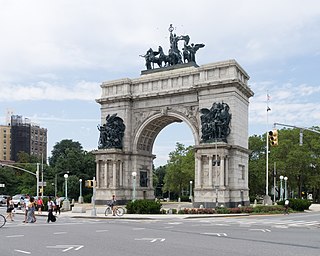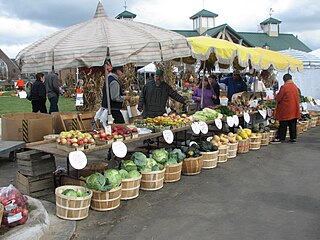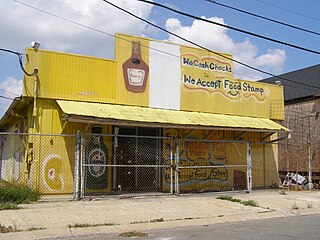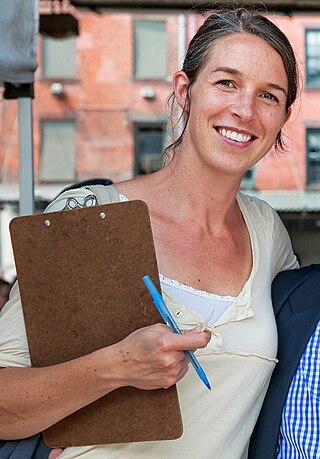
Grand Army Plaza, originally known as Prospect Park Plaza, is a public plaza that comprises the northern corner and the main entrance of Prospect Park in the New York City borough of Brooklyn. It consists of concentric oval rings arranged as streets, with the namesake Plaza Street comprising the outer ring. The inner ring is arranged as an ovoid roadway that carries the main street – Flatbush Avenue. Eight radial roads connect Vanderbilt Avenue; Butler Place; two separate sections of Saint John's Place; Lincoln Place; Eastern Parkway; Prospect Park West; Union Street; and Berkeley Place. The only streets that penetrate to the inner ring are Flatbush Avenue, Vanderbilt Avenue, Prospect Park West, Eastern Parkway, and Union Street.

A farmers' market is a physical retail marketplace intended to sell foods directly by farmers to consumers. Farmers' markets may be indoors or outdoors and typically consist of booths, tables or stands where farmers sell their produce, live animals and plants, and sometimes prepared foods and beverages. Farmers' markets exist in many countries worldwide and reflect the local culture and economy. The size of the market may be just a few stalls or it may be as large as several city blocks. Due to their nature, they tend to be less rigidly regulated than retail produce shops.

Union Square is a historic intersection and surrounding neighborhood in Manhattan, New York City, United States, located where Broadway and the former Bowery Road – now Fourth Avenue – came together in the early 19th century. Its name denotes that "here was the union of the two principal thoroughfares of the island". The current Union Square Park is bounded by 14th Street on the south, 17th Street on the north, and Union Square West and Union Square East to the west and east respectively. 17th Street links together Broadway and Park Avenue South on the north end of the park, while Union Square East connects Park Avenue South to Fourth Avenue and the continuation of Broadway on the park's south side. The park is maintained by the New York City Department of Parks and Recreation.

A market garden is the relatively small-scale production of fruits, vegetables and flowers as cash crops, frequently sold directly to consumers and restaurants. The diversity of crops grown on a small area of land, typically from under 0.40 hectares to some hectares, or sometimes in greenhouses, distinguishes it from other types of farming. A market garden is sometimes called a truck farm in the USA.

Foley Square, also called Federal Plaza, is a street intersection in the Civic Center neighborhood of Lower Manhattan, New York City, which contains a small triangular park named Thomas Paine Park. The space is bordered by Worth Street to the north, Centre Street to the east, and Lafayette Street to the west, and is located south of Manhattan's Chinatown and east of Tribeca. It was named after a prominent Tammany Hall district leader and local saloon owner, Thomas F. "Big Tom" Foley (1852–1925).
The grain trade refers to the local and international trade in cereals such as wheat, barley, maize, and rice, and other food grains. Grain is an important trade item because it is easily stored and transported with limited spoilage, unlike other agricultural products. Healthy grain supply and trade is important to many societies, providing a caloric base for most food systems as well as important role in animal feed for animal agriculture.
Nina Planck is a food writer and farmers' market entrepreneur.

Environmental issues in New York City are affected by the city's size, density, abundant public transportation infrastructure, and location at the mouth of the Hudson River.

Travers Park is a 2-acre (8,100 m2) community park and playground in Jackson Heights, Queens, New York City. It is located between 77th and 78th Streets, on the north side of 34th Avenue. More than half of the park is occupied by an asphalt play area, with basketball and tennis courts. A children's playground with leaf-and-vine shaped spray shower occupies about one third of the park. There are also restroom facilities, handball courts, a dog run, picnic tables, a bicycle rack, benches, tables, and a lawn. In 2012, a segment of adjacent 78th Street was transformed into a permanent Street Plaza; the sports area of a nearby school was also bought by New York City and added to the park.

A marketplace or market place is a location where people regularly gather for the purchase and sale of provisions, livestock, and other goods. In different parts of the world, a marketplace may be described as a souk, bazaar, a fixed mercado (Spanish), or itinerant tianguis (Mexico), or palengke (Philippines). Some markets operate daily and are said to be permanent markets while others are held once a week or on less frequent specified days such as festival days and are said to be periodic markets. The form that a market adopts depends on its locality's population, culture, ambient and geographic conditions. The term market covers many types of trading, as market squares, market halls and food halls, and their different varieties. Thus marketplaces can be both outdoors and indoors, and in the modern world, online marketplaces.
The Department of City Planning (DCP) is the department of the government of New York City responsible for setting the framework of city's physical and socioeconomic planning. The department is responsible for land use and environmental review, preparing plans and policies, and providing information to and advising the Mayor of New York City, Borough presidents, the New York City Council, Community Boards and other local government bodies on issues relating to the macro-scale development of the city. The department is responsible for changes in New York City's city map, purchase and sale of city-owned real estate and office space and of the designation of landmark and historic district status. Its regulations are compiled in title 62 of the New York City Rules. The most recent Director of City Planning Marisa Lago resigned in December, 2021 following her confirmation as Under Secretary for International Trade at the United States Department of Commerce.

In New York City, there is an extensive water supply system that supports several programs and infrastructure pertaining to the city's food supply. City officials, agencies, and organizations cooperate with rural farmers to grow food more locally, as well as protect waterways in the New York metropolitan area. The New York City Department of Education operates a school-time and summertime breakfast/lunch program. The city is also deprived of supermarkets in several neighborhoods, and the city government has addressed the problem by allowing extra street vendors to operate. To encourage food safety, the government also operates a restaurant-grading system that it introduced in 2010. The various food programs have made the city a model for food systems internationally.

Supermarket shortages have been identified in many American urban neighborhoods, and such gaps in food access have been closely correlated with diet-related diseases such as cancer, obesity, and diabetes. The shortage began when many supermarkets left mixed-income central city neighborhoods after civil disturbances in the late 1960s and 1970s. By 1984, store openings exceeded closings nationally, but the opposite held in cities; and the trend continues. The reluctance of large chains to open in urban areas is termed by some activists, "supermarket redlining."

Farm-to-table is a social movement which promotes serving local food at restaurants and school cafeterias, preferably through direct acquisition from the producer. This might be accomplished by a direct sales relationship, a community-supported agriculture arrangement, a farmer's market, a local distributor or by the restaurant or school raising its own food. Farm-to-table often incorporates a form of food traceability where the origin of the food is identified to consumers. Often restaurants cannot source all the food they need for dishes locally, so only some dishes or only some ingredients are labelled as local.

Brooklyn Grange is a 5.6-acre organic urban rooftop farm in New York City, growing vegetables and honey for local restaurants, markets, and community-supported agriculture. The farm is located on three rooftops in Brooklyn and Queens. The first rooftop farm was established in 2010 on a 43,000 square feet building straddling Astoria and Long Island City areas. The second location was built in 2012 atop the Brooklyn Navy Yard and the third farm, established in 2019, is located at Liberty View in Sunset Park, Brooklyn. All three locations encompass 140,000 square feet of space, making it the largest rooftop farm in New York City. Annually, 80,000 pounds (36,000 kg) of organic vegetables are grown.
East New York Farms! (ENYF) is a community organization created to address food justice issues in the East New York neighborhood of Brooklyn, New York.
GrowNYC is an environmental organization founded in 1970 and based in New York City, originally named the Council on the Environment of New York City (CENYC). GrowNYC is dedicated to the improvement New York City's quality of life through environmental programs, including Farmers' markets, community recycling, gardening, and environmental education.
Gotham Greens is an American fresh food and urban agricultural company founded and headquartered in the Brooklyn borough of New York City that grows local produce year-round in greenhouses, with its lettuces, herbs, salad dressings and sauces sold under its brand name. The company owns and operates nine hydroponic greenhouse facilities in the United States.

Anne Therese Saxelby was an American artisanal cheesemaker and cheesemonger. She was the founder of Saxelby Cheesemongers, the first shop dedicated to American artisanal cheeses in New York City. She was a major figure in the growth and promotion of the American artisanal cheese industry.













